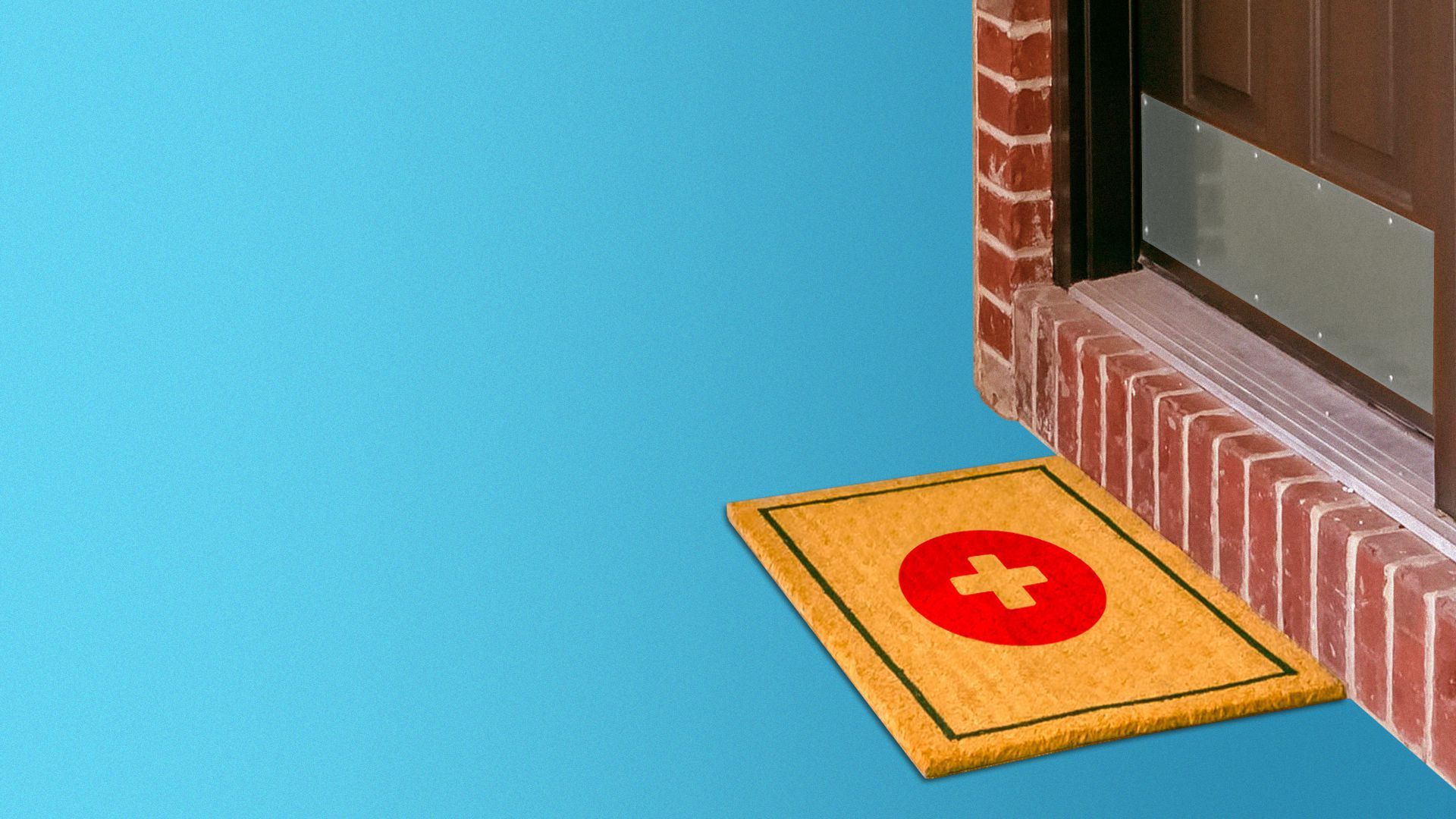| | | | | | | Presented By PhRMA | | | | Axios Vitals | | By Tina Reed · Dec 01, 2022 | | ☃️ It's December, Vitals readers! (How'd that happen?) 1 fun thing: We're all about the canine-related health news this week. Today, Axios' Alison Snyder has a story about a biotech startup that is predicting the age of dogs in the hunt for clues about human aging. Today's newsletter is 912 words or a 3.5-minute read. | | | | | | 1 big thing: Hospital care at home faces possible sunset |  | | | Illustration: Gabriella Turrisi/Axios | | | | A pandemic-driven workaround that delivers hospital-level care in patients' homes could become a bargaining chip as Congress hashes out a year-end spending deal. Why it matters: The Acute Hospital Care at Home program is held up in some health circles as a viable alternative for treating frail Medicare patients while relieving overcrowding in inpatient settings. - But it's one of a long list of COVID-era flexibilities that could sunset at the end of the public health emergency without congressional action.
How it works: Since the fall of 2020, hospitals can apply for waivers and, if approved, be reimbursed the same amount by Medicare to provide 24/7 nursing services in patients' homes. - 257 hospitals in 37 states are currently using waivers to provide acute hospital-level care, working with companies like Medically Home and DispatchHealth.
- But while the public health emergency runs through at least April, advocates for the model say the push for more decentralized care hinges on Medicare's continued involvement — and on lawmakers extending the program and providing some certainty beyond the crisis.
- "Once the PHE ends, if there isn't something like this, they're going to have to stop offering this care for Medicare and Medicaid fee-for-service," said Rami Karjian, CEO of Medically Home, which is backed by health systems like Mayo Clinic and Kaiser Permanente.
Go deeper: The leading vehicle is a plan from Sens. Rick Scott (R-Fla.) and Tom Carper (D-Del.) that would extend waivers for Acute Hospital Care at Home for at least two years beyond the expiration of the emergency. - "This looks to me like something that's pretty clear cut, takes pressure off, adds value, saves a little money and deals with the amazing stress on providers and patients," Rep. Earl Blumenauer (D-Ore.), who's co-sponsored a House companion bill, told Axios.
Yes, but: The extension is one of numerous end-of-year priorities lawmakers will have to sort through. Congressional scorekeepers haven't yet put a price tag on the bill. - Offering high-level care outside of hospitals can be a costly proposition.
- Some providers also remain reluctant to discharge patients to home settings or adapt to treating patients outside of institutional settings, per HealthcareDive.
Go deeper. |     | | | | | | 2. Senior deaths from alcohol, drug use skyrocket |  Reproduced from NCHS; Chart: Axios Visuals Deaths from drug and alcohol use among adults 65 and older have climbed precipitously over the last two decades, federal data released Wednesday shows. Why it matters: While these fatalities still make up a relatively small number of overall deaths in this population, experts say the data points to an overlooked and growing problem for seniors, who are more likely to partake than previous generations at their age. What they're saying: "It looks like older adults are continuing to party into their older years," said Maryann Mason, associate professor at Northwestern's Feinberg School of Medicine, who published similar findings earlier this year in JAMA. - "But they have more adverse consequences due to multiple medications, the issues of aging, isolation, depression, those things," Mason said.
By the numbers: Death rates from drug overdoses among people 65 and older more than tripled over 20 years, from 2.4 deaths per 100,000 people in 2000 to 8.8 in 2020. - Death rates from fentanyl and other synthetic opioids increased 53% from 2019 to 2020 for that age group.
- Age-adjusted death rates for alcohol-induced causes among seniors have also been on the rise since 2011 and jumped 18% between 2019 and 2020.
- Alcohol use by seniors, in particular, is a growing concern, followed by prescription medication opioids and benzodiazepines, Nzinga Harrison, co-founder of Eleanor, a mental health and addiction treatment company, told Axios in an email.
|     | | | | | | 📈 3. Consumer inflation outpaces health care | | In any given year, medical inflation typically outpaces growth in the rest of the economy, but soaring consumer prices have flipped the trend, according to the latest Peterson-KFF Health System Tracker. Why it matters: While health care prices have remained relatively steady, they're likely to eventually follow broader inflation, particularly as the industry absorbs steep increases in labor costs and medical supplies. Overall, consumer prices in October grew 7.7%, according to the Consumer Price Index, while prices for medical care grew 5%. - Yes, but: Since 2000, the price of medical care has risen by about 110%, compared to 71% for consumer goods and services in the same period.
What's happening: Public payers prices are set on an annual basis, so it creates a lag in observable health sector prices, per the tracker. Between the lines: Health systems sustained another tough month in October, and many hospitals nearing the end of the year with negative margins due to rising expenses, staff shortages and fewer patient discharges, according to the National Hospital Flash Report released Wednesday by Kaufman Hall. |     | | | | | | A message from PhRMA | | Patients are frustrated | | |  | | | | New data from IQVIA reveal patients with deductibles and coinsurance are more likely to abandon their medicines than patients with copays. The reason: Insurers and their PBMs shift the costs of covered medicines onto their patients. That's not fair. Learn more. | | | | | | 4. Quote du jour | | "When people hear the words fentanyl and overdose, what they understand is the old war on drugs, and people suffering from addiction ... The new demographic is people who unwittingly consume fentanyl thinking they are taking a harmless product." — Chris Didier, father of a teenager who died of a fentanyl overdose told the Washington Post in a story about how the drug is being distributed via social media channels like Facebook and Snapchat. |     | | | | | | 5. Catch up quick | | 🙊 Elon Musk highlighted monkey "telepathic typing" at a Neuralink event. (Axios) 👉 A measles outbreak in Ohio has increased to 46 cases and 3 sites. (Columbus Dispatch) 🦠 The FDA pulled U.S. authorization for Eli Lilly's COVID drug bebtelovimab due to the evolution of the virus. (Reuters) 🚬 A group of tobacco companies is asking the Supreme Court to stop a flavored-tobacco ban from going into effect later this month in California. (The Hill) |     | | | | | | A message from PhRMA | | Data show PBMs shift costs to patients | | |  | | | | Costly out-of-pocket expenses tied to deductible and coinsurance requirements are a leading concern for patients with commercial insurance. New IQVIA data break down how insurers and their PBMs are impacting how patients access and afford their medicines. | | | | 👋 Thanks for reading, and thanks to senior editor Adriel Bettelheim and copy editor Nick Aspinwall for the edits. Did someone forward this email to you? Here's how to sign up. |  | | Your personal policy analyst is here. | | | | | | Axios thanks our partners for supporting our newsletters. If you're interested in advertising, learn more here.
Sponsorship has no influence on editorial content. Axios, 3100 Clarendon Blvd, Arlington VA 22201 | | | You received this email because you signed up for newsletters from Axios.
Change your preferences or unsubscribe here. | | | Was this email forwarded to you?
Sign up now to get Axios in your inbox. | | | | Follow Axios on social media:    | | | | | |
No comments